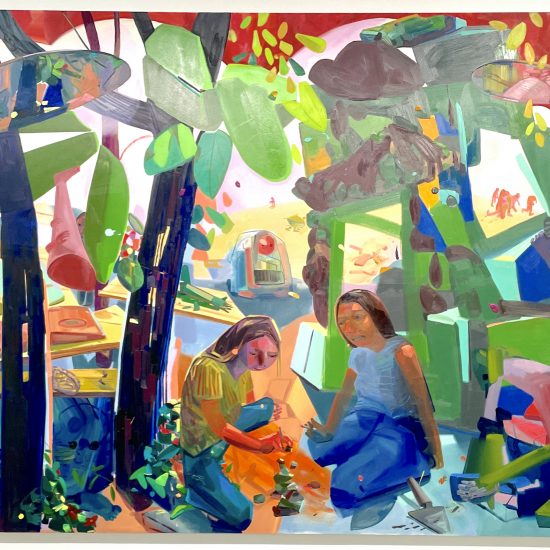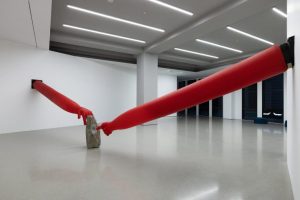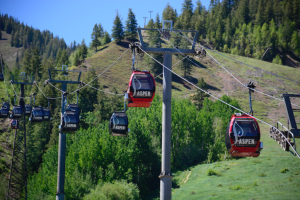BERLIN and PARIS — In recent years, impending ecological apocalypse has spurred a number of contemporary artists to visualize fears of an environmental collapse. Yet it’s also inspired artists to imagine post-apocalyptic futures. British artist Emma Talbot and American artist Dana Schutz address the subject of societal, ecological meltdown in their recent shows, organized respectively at Kindl, Berlin, and at Musée d’Art Moderne (MAM), Paris. While they draw the spectators’ attention to humanity’s absurdities, contradictions, and collective inefficacy, they offer paths to eco-centric renewal as well. Looking at their paintings, I couldn’t help thinking of late American writer Ursula K. Le Guin’s futuristic stories, some of which envisioned nonhuman, eco-based intelligence.
Technology and contemporary society’s addiction to it are central to Talbot’s paintings, featured in the group show POLY: A Fluid Show, curated by Solvej Helweg Ovesen, at Kindl Center for Contemporary Art, Berlin. The exhibition is devoted to contemporary artists whose works consider the idea of pollination, derived from biology, as the basis for re-envisioning societal structures, emphasizing collectivity and hybridity. In her collage across six silk panels, “When Screens Break” (2020), Talbot paints faceless avatars floating amid colorful amoebas and black and white webs. Speech balloons with underlined text describe a world that’s so technologically mediated that when smartphones break, they leave a harrowing sense of emptiness. “When Screens Break” is also the title of an animation playing on a small screen on the floor, in which a lonely figure grieves the loss of screen interaction.
Talbot’s site-specific mini exhibition, Emma Talbot: In the End, the Beginning (2023), also at Kindl, plays out as a sequel to the accelerated post-human future as glimpsed in the group exhibition. Talbot fills the soaring space at Kindl’s Kesselhaus with enormous paintings on silk suspended from the ceiling, along with fabric sculptures. She displaces the centrality of the human figure, instead centering giant spiders painted on silk in the section Materials for Survival. Many other creatures are combines (e.g., plant-animals, humanoid-insects). In its exuberant fecundity, the post-human world is seductive. Only upon closer inspection is it clear that Talbot renders nature’s revenge — for instance, the River Styx rising against humans’ rapaciousness (the text bubbles name capitalism and greed as primary culprits). But the paintings also weave the human body into sprawling mosaics of fertile, fungible forms, reminding viewers that we’re made of the same chemical elements found in nature. Knocked off nature’s pedestal, human consciousness may learn from nature’s inbuilt, multiple intelligences, and from our common organic foundation, to survive, then to regrow.
Much like Talbot, Dana Schutz builds on recognizable social scenarios for her pre- and post-apocalyptic compositions. Dana Schutz: Le Monde Visible, the first survey of her work in France, curated by Anaël Pigeat at MAM, Paris, and co-organized with the Louisiana Museum in Denmark, is a veritable whirlwind of social dystopias. In the oil painting “Men’s Retreat” (2005) — an eerie grotesque in sickeningly bright colors — grown and middle-aged men wearing neckties, stripped to tank tops, faces painted or blindfolded, frolic at an outdoorsy retreat, yet their expressions convey a peculiar sense of senility and menace. Other tableaux are more explicit: in “Presentation” (2005), a somber crowd witnesses a vivisection (of a living subject?), complacent in the spectacle, while in “Fanatics” (2005), masqueraded citizens crowd angrily behind a metal-fence barricade. Finally, “Beat Out the Sun” (2018) depicts the absurdist scenario of an inscrutable, cartoonish mob — climate-change deniers, no doubt — marching shoulder to shoulder to attack the scorching disc hovering dangerously low on the horizon.
While neither Talbot nor Schutz places responsibility for climate-response failure squarely on patriarchal systems, for both artists, specifically female-identified bodies seem central to the world’s post-apocalyptic future. Talbot’s sculpture of a multi-tentacled insect, for instance, features long-haired wigs and nimble humanoid limbs as vestiges of the human, whereas her collages also include breasted figurines evoking ancient deities amid the webby patterns. Not suggesting that we tame the wild, Talbot instead emphasizes the resilience of the human, particularly female, body, and its capacity for rebirth, as essential to the survival of the entire species.

In Schutz’s paintings, women are empirical world builders. She paints them as deeply focused, blocking out the surrounds of an encroaching jungle — part greenery, part cement — populated by semi-human and robotic beings. “Civil Planning” (2004), which depicts this scene, satirizes the futility of human endeavors, but also pays wistful homage to perseverance. In another painting, “Reformers” (2004), women lean over a collapsed table, on which a marionette-like figure has broken in half — another frustrated collective effort.
Though the humanity depicted in most of Schutz’s works suggests an inborn haplessness, she offers some hope for the post-apocalyptic future. In “New Legs” (2003), a raw-pink-fleshed blond woman seated on an empty beach atop a pile of rough-hewn rocks is fashioning a pair of legs: Eve re-inventing herself in a depopulated world, in which she can only count on her ingenuity (though she may also be molding a knobby fetish of Adam). Schutz’s large painting “The Visible World” (2018), after which the show is titled, is an odyssey centered on a nude female figure, swept up on a rock by crushing waves. A bird perched on her thigh holds a red sphere, possibly a pomegranate, in its open beak. The painting’s opaque symbolism, which may hint at the limits of human empiricism, conveys a sense that this shipwrecked, grief-stricken, somewhat de Kooning-esque creature (the wall text refers to her as a traffic-light-green-eyed Prometheus) may yet be the planet’s only hope.





POLY: A Fluid Show continues at Kindl Center for Contemporary Art (Am Sudhaus 3, Berlin, Germany) through February 25. The exhibition was curated by Solvej Helweg Ovesen.
Emma Talbot: In the End, the Beginning continues at Kesselhaus at the Kindl (Am Sudhaus 3, Berlin, Germany) through May 26. The exhibition was curated by Kathrin Becker.
Dana Schutz: Le Monde Visible continues at Musée d’Art Moderne (MAM) (11 Avenue du Président Wilson, Paris, France) through February 11. The exhibition was curated by Anaël Pigeat, assisted by Alexandra Jouanneau, and organized by MAM in collaboration with the Louisiana Museum in Denmark.




